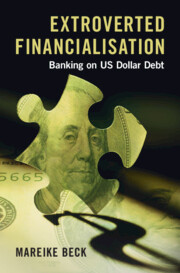Book contents
- Extroverted Financialisation
- Studies in Macroeconomic History
- Extroverted Financialisation
- Copyright page
- Dedication
- Epigraph
- Contents
- Figures
- Acknowledgements
- 1 Introduction
- 2 Extroverted Financialisation
- 3 The Pfandbrief
- 4 The Eurodollar Roots of the German Model
- 5 Grounding USDs
- 6 Liability Management and the Transformation of Deutsche Bank
- 7 Commerzbank
- 8 Financialised Banking and Its Discontents
- 9 Conclusion
- References
- Index
3 - The Pfandbrief
Securitisation Made in Germany
Published online by Cambridge University Press: 07 August 2025
- Extroverted Financialisation
- Studies in Macroeconomic History
- Extroverted Financialisation
- Copyright page
- Dedication
- Epigraph
- Contents
- Figures
- Acknowledgements
- 1 Introduction
- 2 Extroverted Financialisation
- 3 The Pfandbrief
- 4 The Eurodollar Roots of the German Model
- 5 Grounding USDs
- 6 Liability Management and the Transformation of Deutsche Bank
- 7 Commerzbank
- 8 Financialised Banking and Its Discontents
- 9 Conclusion
- References
- Index
Summary
Chapter 3 starts the recalibration of financialisation by telling an alternative history of German finance. It zooms in on the struggles over deposits to provide the historical and institutional backdrop to appreciate the key differences and overlaps in US and German financial markets, and to understand those financial developments that set them apart from the 1960s onwards. This chapter examines the development of the Pfandbrief (covered bond) from the eighteenth century onwards to establish that market-based funding practices have a long history in Germany. After the devastation of the Seven Years’ War (1756–1763), banks and the state (the Prussian prince and its gentry) together sought new ways to boost lending and borrowing with the help of financial securities and collateral. This chapter shows that German housing finance was historically much more market-based than in the US. While the Pfandbrief has been a key financial security promoting long-term lending, it was used predominantly by specialised mortgage and public savings banks. Universal banks only entered the fray in the 1970s when their corporate deposits declined. Chapter 3 shows that German banking was geared towards market-based finance but different to the one that emerged as part of US-led financialisation.
Keywords
Information
- Type
- Chapter
- Information
- Extroverted FinancialisationBanking on US Dollar Debt, pp. 53 - 68Publisher: Cambridge University PressPrint publication year: 2025
Accessibility standard: WCAG 2.0 A
Why this information is here
This section outlines the accessibility features of this content - including support for screen readers, full keyboard navigation and high-contrast display options. This may not be relevant for you.Accessibility Information
Content Navigation
Allows you to navigate directly to chapters, sections, or non‐text items through a linked table of contents, reducing the need for extensive scrolling.
Provides an interactive index, letting you go straight to where a term or subject appears in the text without manual searching.
Reading Order & Textual Equivalents
You will encounter all content (including footnotes, captions, etc.) in a clear, sequential flow, making it easier to follow with assistive tools like screen readers.
You get concise descriptions (for images, charts, or media clips), ensuring you do not miss crucial information when visual or audio elements are not accessible.
Structural and Technical Features
You gain clarity from ARIA (Accessible Rich Internet Applications) roles and attributes, as they help assistive technologies interpret how each part of the content functions.
